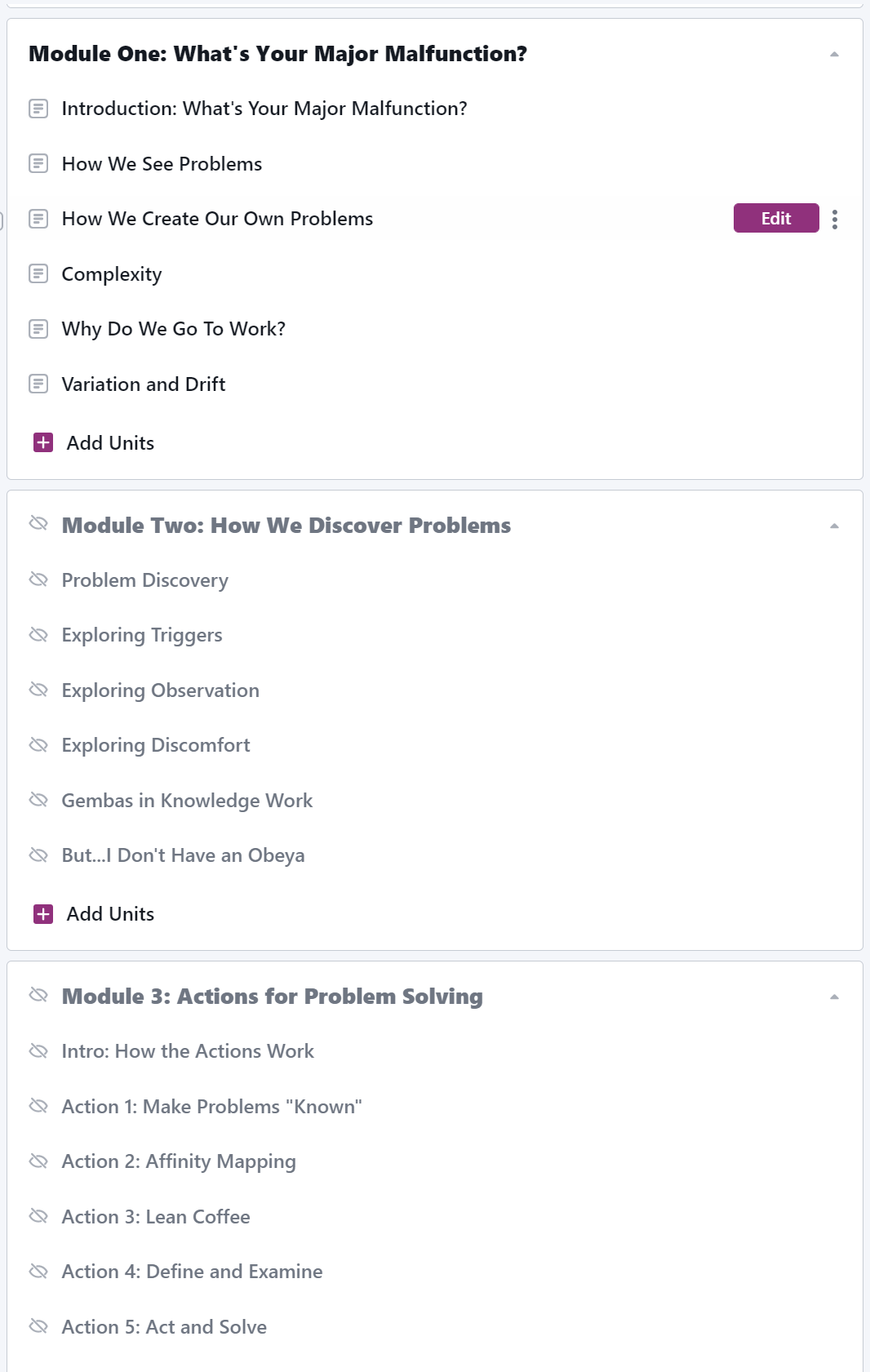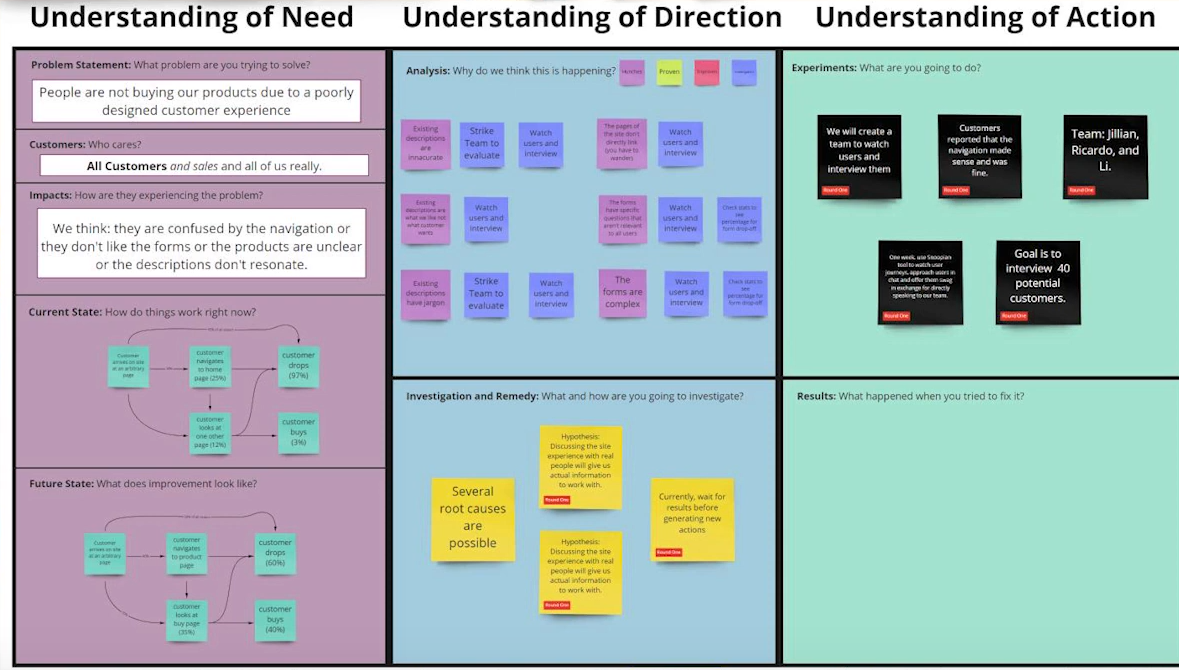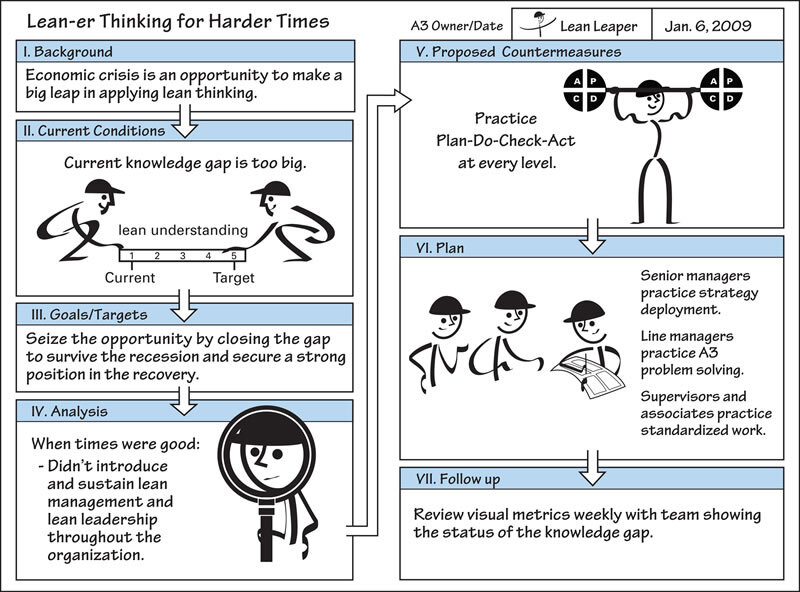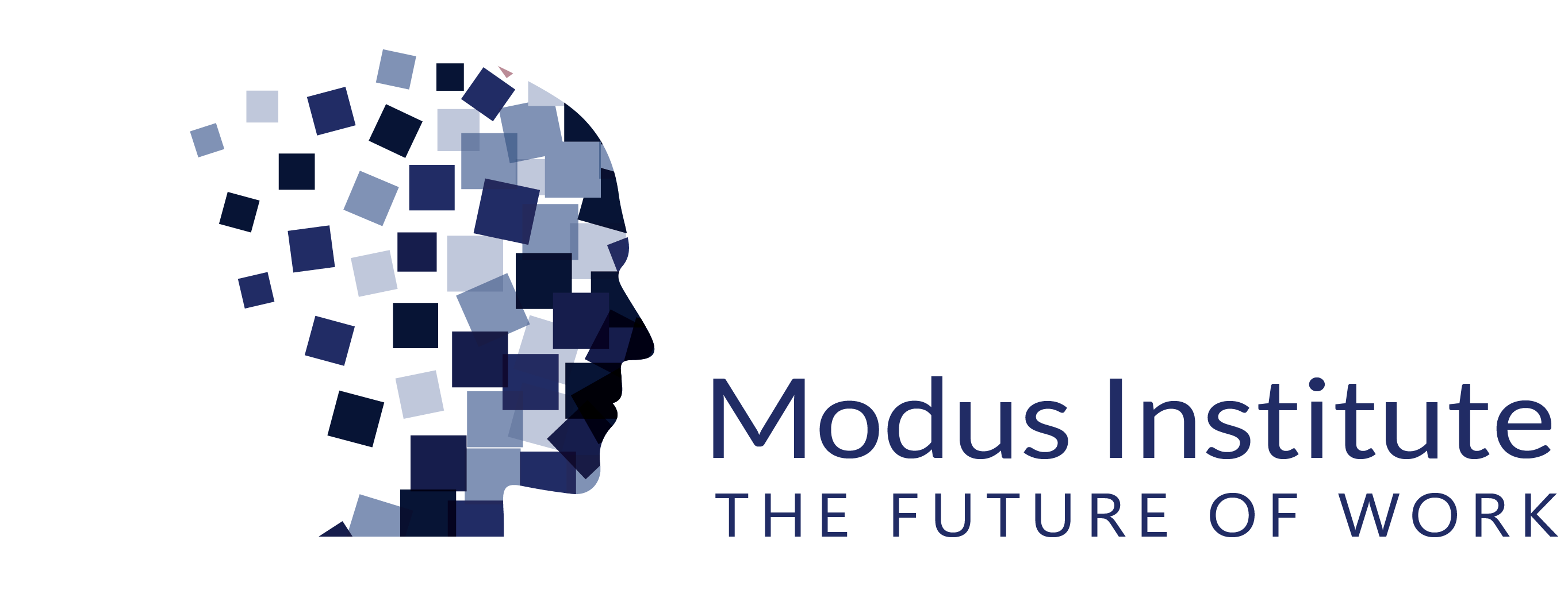Problem Solving 101: How to Use A3s for Knowledge Work
In this video and in our upcoming Problem Solving for Knowledge Work class, we take the Lean A3 tool popularized by John Shook and others, and expand it for use in knowledge work.
How do I learn more about the systems an A3 would be useful in?
In our upcoming class the A3 tool plugs into an entire system of A3 thinking. Be sure to check out Finding Solutions: Problem Solving for Knowledge Work, which will be included in the Modus Institute Platinum Subscription.
This class covers not just the A3s and their intricacies, but also the greater problem solving environment in which they fit: the culture, the tools for refinement and analysis, and the challenges of getting others to regularly engage in problem solving activities as part of their standard work.
Here’s a sneak preview of what will be included:
This class covers not just the A3s and their intricacies, but also the greater problem solving environment in which they fit: the culture, the tools for refinement and analysis, and the challenges of getting others to regularly engage in problem solving activities as part of their standard work.
Here’s a sneak preview of what will be included:

What is an A3 Used for?
When you have a problem, a potential improvement, or an opportunity for innovation, there are unknowns you need to solve for. The A3 is a single sheet of paper or grid on a screen that provides space to see the problem, the current state, the issues that could be solved, plans to solve them/the thinking behind the solution, and then the results of those actions.
How is an A3 Different for Knowledge Work?
Knowledge work has greater variation, political issues, and complexities than work that is in a more controlled assembly line or manufacturing scenario. There are usually more people involved, and more stakeholders means more collaboration is required for finding a solution. Lastly, the “Gemba” for knowledge work - the location where value is created - is much less observable than in physical work thus requiring deeper systems to find solutions.
The A3 (and Lean in general), is extremely useful for getting things done, solving problems, and improving our work, but it requires some adjustments for a modern knowledge work or agile environment.
The A3 (and Lean in general), is extremely useful for getting things done, solving problems, and improving our work, but it requires some adjustments for a modern knowledge work or agile environment.
What is "A3 Thinking?"

A3 Thinking is when a professional or a team of professionals understand that problems or impediments to work result in delays, defects, and professional frustration. They understand that when problems are solved quickly and responsibly, they do not spiral out of control. Therefore, when problems, complexities, or opportunities arise they don’t just want to solve them…they actually have a way to solve them.
When you have an existing way to improve the work you do, the product you create, and the culture in which you work, problems cease to be emergencies and instead become opportunities.
A3 thinking is nothing less than understanding this simple wisdom and making good on it by having an easy to follow set of practices to solve the problem quickly, and move on.
When you have an existing way to improve the work you do, the product you create, and the culture in which you work, problems cease to be emergencies and instead become opportunities.
A3 thinking is nothing less than understanding this simple wisdom and making good on it by having an easy to follow set of practices to solve the problem quickly, and move on.
What is Problem Solving?
Problem solving is taking something you don’t understand or is causing you personal or professional pain and making it go away. It can be a “problem,” but it can also be an opportunity, an opening for innovation, or a cumbersome process you are used to but if you make it go away work will be a lot easier.
Current State: Your current state is the state of things right now.
Future State: A future state is a scenario you can envision where things would work better.
Problem solving is taking that current state and improving upon it until it becomes a more desirable future state.
Current State: Your current state is the state of things right now.
Future State: A future state is a scenario you can envision where things would work better.
Problem solving is taking that current state and improving upon it until it becomes a more desirable future state.
Why Do I Need an A3?

An A3 is going to be part of your strategy for problem solving. You need it because it is a tool for focus, collaboration, and progress.Normal text.
Focus and A3s:
The A3 causes you to focus not just on the problem, but on your assumptions about the problem. As you work with the format, you will define your current state, your problem statement, your analysis, your discoveries, your experiments, your proposed fixes, and the results of those fixes. This creates a loop known as PDSA: Plan, Do, Study, Adjust (also known as PDCA: Plan, Do, Check, Act. We recommend you stick with PDSA if you can, it’s clearer to everyone).
That loop is important. As humans we tend to see a problem, quickly envision a cause, and then either act without thinking at all or, endeavor to prove that our first impulse was right. This is what psychologists call "Confirmation Bias."
An A3 helps us avoid confirmation bias by providing a format that invites us to investigate when our impulse would be to act. In our decade or so of working with A3s across countless fields and verticles, we have never seen someone end an A3 exercise with the same problem statement that they began with. This is an important statement.
The cycle of problem definition -> investigation -> action -> learning -> re-definition -> etc. is a powerful scientific approach to situations we find annoying or weird. The A3 makes that visual, allowing you to focus on the section-at-hand (like action), while making sure you remember and see the impacts of your observations on the other sections (like redefinition).
That loop is important. As humans we tend to see a problem, quickly envision a cause, and then either act without thinking at all or, endeavor to prove that our first impulse was right. This is what psychologists call "Confirmation Bias."
An A3 helps us avoid confirmation bias by providing a format that invites us to investigate when our impulse would be to act. In our decade or so of working with A3s across countless fields and verticles, we have never seen someone end an A3 exercise with the same problem statement that they began with. This is an important statement.
The cycle of problem definition -> investigation -> action -> learning -> re-definition -> etc. is a powerful scientific approach to situations we find annoying or weird. The A3 makes that visual, allowing you to focus on the section-at-hand (like action), while making sure you remember and see the impacts of your observations on the other sections (like redefinition).
Collaboration and A3s:
Traditional A3s are often collaborative in the sense that one author of an A3 will seek support from others. In knowledge work, problems are often extremely complicated or complex (see Dave Snowden’s Cynefin Framework 🔗) The more complex a problem (and this includes institutional or internally political complexity), the more people are required to solve the problem. The number of potential root causes, desirable future states, and issues (cost, time, staffing, etc.) involved in finding a solution require collaboration.
Also in knowledge work many if not most problems to solve involve the interactions of the individual professionals on the project. They are political in nature and require participation by the stakeholders.
The good news: solving problems together makes a lot of those issues go away.
Also in knowledge work many if not most problems to solve involve the interactions of the individual professionals on the project. They are political in nature and require participation by the stakeholders.
The good news: solving problems together makes a lot of those issues go away.
Progress through A3s:
As you watch the video, you’ll see the team move through an A3 and you will be able to see their progress - visually. You can see the stages of their growth in understanding their problem, in understanding how they investigate things together, how they work to find the appropriate solutions to a complex issue. You will see, along with them, their realizations of which of their initial assumptions were correct and which were not. You’ll see them solve and implement in real time.

What Does an A3 Look Like?
Watch the video at the beginning to see it in practice!
How Do I Learn More About the Systems an A3 Would be Useful in?
This is already a long blog post and video. The A3 plugs into a system of A3 Thinking we explore in our upcoming class Finding Solutions: Problem Solving for Knowledge Work, which will be part of the Modus Institute Platinum Subscription.
This class covers not just the A3s and their intricacies, but also the greater problem solving environment in which they reside: the culture, the tools for refinement and analysis, and the challenges of getting others to regularly engage in problem solving activities as part of their standard work.
This class covers not just the A3s and their intricacies, but also the greater problem solving environment in which they reside: the culture, the tools for refinement and analysis, and the challenges of getting others to regularly engage in problem solving activities as part of their standard work.

We are an online educational platform that helps professionals and aspiring individuals to succeed in their goals.
Copyright © 2025